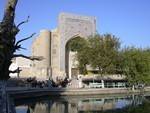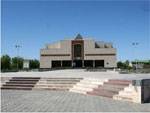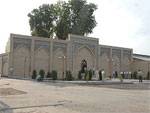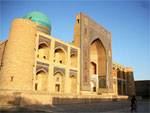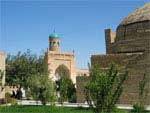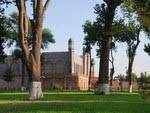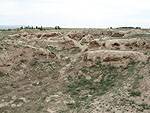Pearl of East: Your travel guide in Uzbekistan.
|
Main Menu
Tashkent
Samarkand
Bukhara
Khiva
Baysun
Nukus
Margilan
Ferghana
Nurata
Namangan
Kokand
Sarmysh Say
Termez
|
News / НовостиUzbekistan: Big city of the middle ages. The capital of the empire.05/05/2015 16:03 Khorezm is contemporary to the ancient Greece and Egypt. The birthplace of the great scientists, the cradle of world civilization Khorezm in its time repeatedly rebuffed such famous opponents as Alexander Makedonskiy, and in 680 AD Arabs Kuteiba ibn Muslim. They attacked Urgench – the capital of Khorezm (formerly Gurgandj), but could not completely subdue the country. In the X century Urgench became one of the largest cities in the world, capital of the empire of Khorezm dynasty Mamunids. With them, especially in the XI-XII centuries, fortifications were built here during the Turkic dynasty during the reign of Khorezm, the city is built with rich residential houses, palaces, markets, houses of Muslim cult. The city's population was about 2 million. And the empire’s territory was larger than the present territory of Central Asia. Mongol invasion (1221 y.) resulted the decline of Urgench. The combined armies of Genghis Khan managed to win. After the semi-siege they destroyed the dam, and Amudarya flooded the Gurgandj. The city was razed to the ground, 100 thousand inhabitants were killed, and every soldier got 24 captive. And only after 200 years the capital of Khorezm was rebuilt. It is known in history that in 1598, the Amu Darya (big river, whose origins are in the Pamirs, at an altitude of 2495 km) retreated from Gurgandj. The Amudarya, flowing through the country’s territory, which flowed into the Caspian Sea, providing residents with water, as well as providing a waterway in Europe. For centuries, the river shifted its course several times. The last turn of the Amu Darya in the late 16th century ruined Gurgandj. The ruins of the ancient capital are at a distance of 150 km from Khiva (territory of Turkmenistan) near the village of Kunya-Urgench, which means “old Urgench”. Kunya-Urgench have survived some building construction, as Caravanserai. The 1st half of the XIV century the Mausoleum of SUFI DYNASTY (known as the tomb Tyurabek Khanum). 60-ies. XIV century Mausoleum of Sultan Ali XIV century or the XVI century (date is not specified). The ensemble “Kosh” with khanaka Nadjmeddin Kubra erected; Khanako of Nadjmeddin Kubra (the founder of the Sufi order Kubraviy, Nadjmeddin Kubra). Between 1321 and 1333 years; Mausoleum of Tekesh Ok. 1200 y; Mausoleum of Fakhreddin-Razi (popular name of the tomb of one of Khorezm kings, apparently Il-Arslan). XII century; minaret of Kutlugh Timur between 1321 and 1333. |
Calendar
Weather
Useful Links
Searching for Airways and Hotels
|


